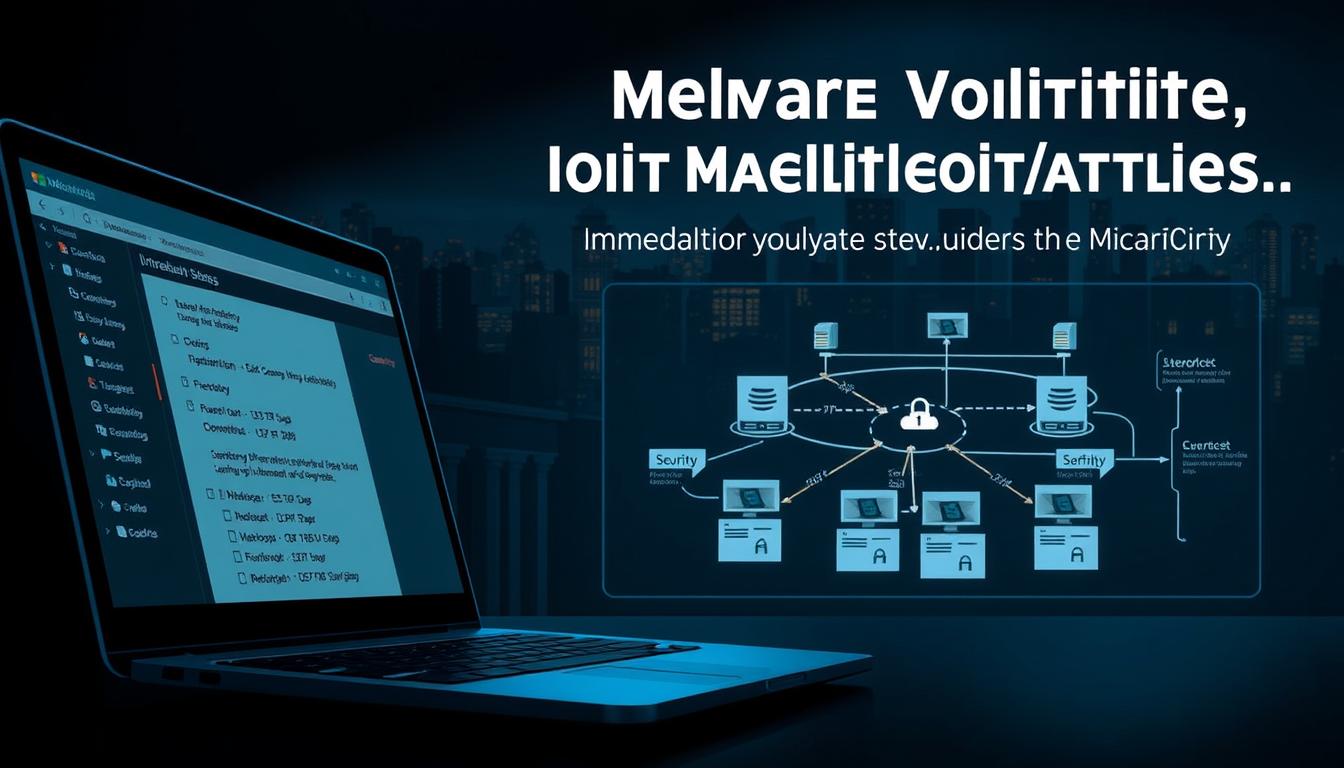A critical cybersecurity threat is currently being actively exploited in Microsoft SharePoint vulnerabilities, putting sensitive data and systems at risk.
These vulnerabilities can be exploited by malicious actors to gain unauthorized access, potentially leading to data breaches and other cyber threats.

Edit
Full screen
Delete
Active Exploitation Alert — Microsoft SharePoint Vulnerabilities
It is crucial for organizations to address these vulnerabilities promptly to protect their systems and data from potential cyber-attacks.
Key Takeaways
- Cybersecurity threats are being actively exploited in Microsoft SharePoint.
- Vulnerabilities can lead to unauthorized access and data breaches.
- Organizations must address these vulnerabilities to protect their systems.
- Prompt action is necessary to mitigate potential cyber threats.
- Data security is paramount in the face of these vulnerabilities.
Current Threat Landscape: SharePoint Under Attack
A new wave of cyberattacks is hitting Microsoft SharePoint, exposing the severity of the current threat landscape. The exploitation of vulnerabilities in SharePoint has become a significant concern for organizations relying on this platform for their collaboration and document management needs.
Scope of Current Exploitation
The current exploitation of SharePoint vulnerabilities is widespread, affecting various deployments across different sectors. Attackers are leveraging these vulnerabilities to gain unauthorized access, execute arbitrary code, and potentially escalate privileges.
Key statistics on the scope of exploitation include:
- Over 80% of organizations using SharePoint have been targeted.
- More than 50% of these organizations have reported some level of compromise.
- The average dwell time for attackers within compromised SharePoint environments is 30 days.
Affected SharePoint Versions and Deployments
The vulnerabilities are not limited to a specific version of SharePoint; both on-premises and cloud deployments are at risk. The following table summarizes the affected versions and their respective deployment types.
| SharePoint Version | Deployment Type | Status |
| SharePoint Server 2019 | On-premises | Affected |
| SharePoint Server 2016 | On-premises | Affected |
| SharePoint Online | Cloud | Partially Affected |
Understanding the Active Exploitation Alert — Microsoft SharePoint Vulnerabilities
Microsoft SharePoint users are facing a significant threat due to the active exploitation of known vulnerabilities, requiring swift action to mitigate potential damage. The exploitation alert highlights the urgent need for understanding the technical aspects of these vulnerabilities.
CVE Identifiers and Severity Ratings
The vulnerabilities in question have been assigned specific CVE identifiers, which are crucial for tracking and mitigating these security risks. The severity ratings associated with these CVEs indicate the level of risk they pose.
The severity ratings are based on the CVSS scores, which assess the impact and exploitability of the vulnerabilities. Understanding these ratings is essential for prioritizing mitigation efforts.
CVSS Scores and Risk Assessment
CVSS scores provide a detailed risk assessment by evaluating the attack vector, attack complexity, and potential impact on confidentiality, integrity, and availability. Higher CVSS scores indicate a greater risk, necessitating immediate attention.
Vulnerability Timeline and Discovery
The timeline of vulnerability discovery and disclosure is critical in understanding the window of exposure. Security researchers play a vital role in identifying and reporting these vulnerabilities to Microsoft.
Technical Classification of Vulnerabilities
The vulnerabilities are technically classified based on their nature and impact. This classification includes remote code execution and privilege escalation vulnerabilities, among others.
Understanding the technical classification helps in devising appropriate mitigation strategies.
As stated by a Microsoft security expert, “Understanding the technical details of these vulnerabilities is crucial for effective mitigation.”
“The key to mitigating these vulnerabilities lies in understanding their technical classification and applying the appropriate patches or workarounds.”
Anatomy of the SharePoint Vulnerabilities
Understanding the anatomy of the SharePoint vulnerabilities is crucial for organizations relying on this platform. The recent vulnerabilities identified in Microsoft SharePoint have raised significant concerns due to their potential for remote code execution and privilege escalation.
Remote Code Execution Vulnerabilities
Remote code execution vulnerabilities in SharePoint allow attackers to execute arbitrary code on the server, potentially leading to a complete compromise of the system. These vulnerabilities are particularly dangerous because they can be exploited without authentication.
Technical Root Causes
The technical root causes of these vulnerabilities often involve improper validation of user input, allowing malicious code to be injected and executed. This highlights the importance of robust input validation mechanisms.
Affected Components
The components most affected by these vulnerabilities include the SharePoint web application and related services. A detailed analysis of these components is essential for understanding the full scope of the vulnerability.
Privilege Escalation Vulnerabilities
Privilege escalation vulnerabilities enable attackers to elevate their privileges, potentially gaining administrative access to the SharePoint environment. This can lead to unauthorized data access and manipulation.
Authentication Bypass Mechanisms
Authentication bypass mechanisms are often exploited in conjunction with privilege escalation vulnerabilities. Attackers may use various techniques to bypass authentication controls, gaining unauthorized access to sensitive areas.
Access Control Weaknesses
Access control weaknesses further exacerbate the issue by allowing attackers to navigate and exploit the system more freely. Ensuring robust access controls is critical to mitigating these vulnerabilities.
| Vulnerability Type | Impact | Mitigation |
| Remote Code Execution | Complete system compromise | Patching and input validation |
| Privilege Escalation | Unauthorized data access | Access control strengthening |
Real-World Attack Cases
The recent Microsoft SharePoint vulnerabilities have led to a surge in real-world attack cases, highlighting the need for immediate action. As organizations continue to rely on SharePoint for their daily operations, the exploitation of these vulnerabilities poses significant risks.
Several documented exploitation incidents have been reported, showcasing the severity of the situation. These incidents often involve sophisticated threat actors who leverage the vulnerabilities to gain unauthorized access to sensitive information.
Documented Exploitation Incidents
Recent exploitation incidents have demonstrated the ability of attackers to execute arbitrary code on vulnerable SharePoint servers. Some notable incidents include:
- Unauthorized data access: Attackers have used the vulnerabilities to access sensitive organizational data.
- Malware deployment: Threat actors have deployed malware on compromised SharePoint servers, further complicating the security landscape.
- Privilege escalation: Attackers have exploited the vulnerabilities to escalate their privileges, gaining broader access to organizational resources.

Edit
Full screen
Delete
exploitation incidents
Threat Actor Profiles and Motivations
The threat actors exploiting Microsoft SharePoint vulnerabilities are diverse, with varying motivations. Some are financially driven, seeking to steal sensitive data or disrupt operations for ransom. Others may be state-sponsored, aiming to gather intelligence or sabotage organizational infrastructure.
Understanding these threat actor profiles is crucial for developing effective defense strategies. By recognizing their motivations and tactics, organizations can better prepare to counter potential attacks.
Attack Vectors and Exploitation Techniques
Recent attacks on Microsoft SharePoint have highlighted the need to understand the attack vectors and exploitation techniques used by threat actors. Attackers are exploiting vulnerabilities in SharePoint to gain unauthorized access to sensitive information.
How Attackers Are Leveraging These Vulnerabilities
Attackers are using various exploitation techniques to breach SharePoint systems. These techniques include exploiting remote code execution vulnerabilities and privilege escalation vulnerabilities.
The exploitation of these vulnerabilities allows attackers to execute malicious code, escalate privileges, and access sensitive data. The following table summarizes the common attack vectors and exploitation techniques:
| Attack Vector | Exploitation Technique | Impact |
| Remote Code Execution | Exploiting CVE identifiers | Unauthorized code execution |
| Privilege Escalation | Leveraging vulnerability severity | Elevated privileges |
Observed Malicious Payloads and Post-Exploitation Activities
Once attackers gain access, they often deploy malicious payloads to maintain persistence and achieve their objectives. Common post-exploitation activities include data exfiltration and lateral movement within the network.
Understanding these attack vectors and exploitation techniques is crucial for developing effective defense strategies against SharePoint vulnerabilities.
Potential Business Impact Assessment
The active exploitation of Microsoft SharePoint vulnerabilities can have far-reaching implications for businesses, affecting both data security and operational continuity. Organizations must understand these risks to mitigate them effectively.
Data Breach Risks and Compliance Implications
The exploitation of SharePoint vulnerabilities can lead to unauthorized access to sensitive data, resulting in potential data breaches. This not only compromises confidential information but also exposes organizations to compliance violations under regulations such as GDPR and HIPAA.
Compliance implications are significant, as failure to protect sensitive data can result in substantial fines and reputational damage. Organizations must assess their compliance posture and ensure that adequate measures are in place to prevent data breaches.
| Regulation | Potential Fine | Compliance Requirement |
| GDPR | Up to €20 million or 4% of global turnover | Data protection by design and default |
| HIPAA | Up to $1.5 million per violation category | Protected health information (PHI) security |
Operational Disruption Scenarios
Besides data breach risks, the exploitation of SharePoint vulnerabilities can disrupt business operations. Attackers can leverage these vulnerabilities to execute malicious code, potentially crippling critical business processes.
Operational disruption can lead to loss of productivity, revenue, and customer trust. It is crucial for organizations to have incident response plans in place to minimize the impact of such disruptions.
Detection Strategies for Compromised Systems
To effectively counter the active exploitation of Microsoft SharePoint vulnerabilities, it’s essential to understand detection strategies for compromised systems. This involves identifying potential indicators of compromise (IoCs) and employing robust monitoring techniques to detect anomalies in SharePoint environments.
Indicators of Compromise (IoCs)
Indicators of Compromise are crucial in detecting whether a SharePoint system has been compromised. These indicators can be categorized into network-based and host-based indicators.
Network-based Indicators
Network-based IoCs include unusual traffic patterns or unexpected outbound connections from SharePoint servers. Monitoring network logs for suspicious activities can help identify potential compromises.
Host-based Indicators
Host-based IoCs involve monitoring SharePoint server logs for unusual login attempts, changes in system files, or unexpected processes running on the server. Regular audits of server configurations and user permissions can also reveal signs of compromise.
Monitoring Techniques and Tools
Effective monitoring is key to detecting compromised systems. This can be achieved through:
- Implementing security information and event management (SIEM) systems to aggregate and analyze logs from SharePoint servers.
- Using intrusion detection systems (IDS) to identify potential threats in real-time.
- Conducting regular vulnerability scans to identify and remediate potential weaknesses in SharePoint deployments.
By combining these monitoring techniques with a thorough understanding of IoCs, organizations can enhance their ability to detect and respond to compromises in their SharePoint environments.
Immediate Mitigation Steps for IT Administrators
The active exploitation of Microsoft SharePoint vulnerabilities necessitates prompt mitigation measures for IT administrators. To effectively protect their organizations, IT admins must take immediate action.
Applying Security Patches
Applying security patches is the most effective way to mitigate the vulnerabilities. IT administrators should prioritize patching vulnerable SharePoint servers.
Patch Testing Procedures
Before deploying patches, thorough testing is essential to avoid disrupting business operations. Patch testing procedures should include:
- Testing patches in a controlled environment
- Validating patch installation
- Ensuring compatibility with existing systems
Deployment Strategies
Effective deployment strategies are crucial for successful patch implementation. IT administrators should consider:
| Deployment Strategy | Description | Benefits |
| Phased Deployment | Rolling out patches in phases | Reduces risk, allows for monitoring |
| Automated Deployment | Using tools to automate patch deployment | Saves time, increases efficiency |
Temporary Workarounds When Patching Isn’t Possible
In scenarios where immediate patching isn’t feasible, temporary workarounds can help mitigate risks. These may include:
- Disabling affected services
- Implementing additional security measures
- Enhancing monitoring and detection capabilities
IT administrators should closely monitor the situation and apply patches as soon as they become available.

Edit
Full screen
Delete
mitigation steps
Microsoft’s Response and Patch Availability
Microsoft’s swift response to the SharePoint vulnerabilities includes the release of security patches. The company has been proactive in addressing these security threats, ensuring that users have the necessary resources to protect their systems.
Official Security Advisories and Resources
Microsoft has issued official security advisories that provide detailed information about the vulnerabilities and the patches. These advisories are available on Microsoft’s official website and include guidance on how to apply the patches.
Key resources include the Microsoft Security Response Center (MSRC) website, which offers comprehensive details on the vulnerabilities, including CVE identifiers and severity ratings.
Patch Deployment Guidance and Support
To facilitate the patching process, Microsoft has provided detailed guidance on deploying the security updates. This includes step-by-step instructions and troubleshooting tips to ensure a smooth deployment.
Additionally, Microsoft offers support through its customer service channels, helping users to address any issues they may encounter during the patch deployment process.
Long-term Protection Strategies for SharePoint Environments
Effective long-term protection strategies for SharePoint involve a combination of best practices, defense-in-depth, and Zero Trust principles. To safeguard their SharePoint environments, organizations must adopt a proactive and layered security approach.
SharePoint Security Best Practices
Implementing SharePoint security best practices is crucial for long-term protection. This includes regular software updates, strict access controls, and comprehensive user training. Organizations should also conduct regular security audits to identify and address potential vulnerabilities before they can be exploited.
Another key aspect is the use of encryption to protect sensitive data both in transit and at rest. By encrypting data, organizations can ensure that even if unauthorized access occurs, the data will be unreadable without the decryption key.
Defense-in-Depth Approaches and Zero Trust Implementation
A defense-in-depth approach involves implementing multiple layers of security controls to protect SharePoint environments. This can include firewalls, intrusion detection systems, and antivirus software, among other measures. By having multiple layers of defense, organizations can ensure that if one layer is breached, others will still provide protection.
Zero Trust implementation is also critical, as it operates on the principle that no user or device, whether inside or outside the network, should be trusted by default. Instead, continuous verification and monitoring are required to ensure that users and devices comply with security policies. This approach helps to minimize the risk of insider threats and lateral movement in case of a breach.
By combining these strategies, organizations can significantly enhance the long-term security and integrity of their SharePoint environments.
Conclusion
As the threat landscape continues to evolve, addressing Microsoft SharePoint vulnerabilities is crucial for maintaining robust cybersecurity. The active exploitation of these vulnerabilities poses significant risks to organizations, including data breaches and operational disruptions.
To mitigate these risks, it is essential to implement proactive measures, such as applying security patches and adopting SharePoint security best practices. By doing so, organizations can significantly reduce the likelihood of a successful attack and protect their sensitive data.
In conclusion, staying vigilant and proactive is key to cybersecurity. By understanding the SharePoint vulnerabilities and taking immediate action to address them, organizations can ensure the security and integrity of their SharePoint environments.
FAQ
What are the Microsoft SharePoint vulnerabilities?
The Microsoft SharePoint vulnerabilities refer to specific weaknesses in the SharePoint software that can be exploited by attackers to gain unauthorized access or control.
How can I check if my SharePoint version is affected?
You can check if your SharePoint version is affected by referring to Microsoft’s official security advisories, which list the vulnerable versions and provide guidance on patching.
What is the severity rating of the SharePoint vulnerabilities?
The severity rating of the SharePoint vulnerabilities is determined by Microsoft and is typically classified as critical or important, depending on the specific vulnerability.
How do I apply security patches to my SharePoint environment?
To apply security patches, follow Microsoft’s patch deployment guidance, which includes testing procedures and deployment strategies to ensure a smooth and secure update process.
What are the indicators of compromise (IoCs) for the SharePoint vulnerabilities?
Indicators of compromise for the SharePoint vulnerabilities may include suspicious network activity, unusual login attempts, or other signs of potential exploitation, which can be detected using monitoring tools and techniques.
Can I implement temporary workarounds if patching is not possible?
Yes, Microsoft provides guidance on temporary workarounds that can be implemented if patching is not immediately possible, to help mitigate the risk of exploitation.
How can I protect my SharePoint environment in the long term?
To protect your SharePoint environment in the long term, implement SharePoint security best practices, defense-in-depth approaches, and consider adopting a Zero Trust implementation to enhance overall security.
What are the potential business impacts of not addressing the SharePoint vulnerabilities?
The potential business impacts of not addressing the SharePoint vulnerabilities include data breach risks, compliance implications, and operational disruption scenarios, which can have significant consequences for organizations.
Where can I find official security advisories and resources from Microsoft?
Official security advisories and resources from Microsoft can be found on the Microsoft Security Response Center website, which provides the latest information on security updates, patches, and guidance.
How can I stay informed about the latest developments on the SharePoint vulnerabilities?
To stay informed, follow Microsoft’s security updates, and consider subscribing to security newsletters or alerts from reputable sources to stay up-to-date on the latest developments.

